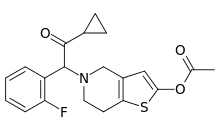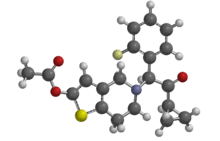Prasugrel
 | |
 | |
| Systematic (IUPAC) name | |
|---|---|
|
(RS)-5-[2-Cyclopropyl-1-(2-fluorophenyl)-2-oxoethyl]-4,5,6,7- tetrahydrothieno[3,2-c]pyridin-2-yl acetate | |
| Clinical data | |
| Trade names | Effient, Efient |
| AHFS/Drugs.com | monograph |
| MedlinePlus | a609027 |
| Licence data | EMA:Link, US FDA:link |
| |
| |
| Oral | |
| Pharmacokinetic data | |
| Bioavailability | ≥79% |
| Protein binding | Active metabolite: ~98% |
| Metabolism | Rapid intestinal and serum metabolism via esterase-mediated hydrolysis to a thiolactone (inactive), which is then converted, via CYP450-mediated (primarily CYP3A4 and CYP2B6) oxidation, to an active metabolite (R-138727) |
| Half-life | ~7 hours (range 2-15 hours) |
| Excretion | Urine (~68% inactive metabolites); feces (27% inactive metabolites) |
| Identifiers | |
|
150322-43-3 | |
| B01AC22 | |
| PubChem | CID 6918456 |
| DrugBank |
DB06209 |
| ChemSpider |
5293653 |
| UNII |
34K66TBT99 |
| KEGG |
D05597 |
| ChEMBL |
CHEMBL1201772 |
| Chemical data | |
| Formula | C20H20FNO3S |
| 373.442 g/mol | |
|
SMILES
| |
| |
| | |
Prasugrel (trade name Effient in the US and India, and Efient in the EU) is a platelet inhibitor developed by Daiichi Sankyo Co. and produced by Ube and currently marketed in the United States in cooperation with Eli Lilly and Company for acute coronary syndromes planned for percutaneous coronary intervention (PCI). Prasugrel was approved for use in Europe in February 2009, and is currently available in the UK. On July 10, 2009, the US Food and Drug Administration approved the use of prasugrel for the reduction of thrombotic cardiovascular events (including stent thrombosis) in patients with acute coronary syndrome who are to be managed with PCI.[1]
Medical uses
P2Y12 inhibitors such as prasugrel do not change the risk of death when given to people who have had a NSTEMI. They do however increase the risk of bleeding and decrease the risk of further cardiovascular problems. Thus their routine use is of questionable value.[2]
Contraindications
Prasugrel should not be given to patients with active pathological bleeding, such as peptic ulcer or a history of transient ischemic attack or stroke, because of higher risk of stroke (thrombotic stroke and intracranial hemorrhage).[3]
Adverse effects
- Cardiovascular: Hypertension (8%), hypotension (4%), atrial fibrillation (3%), bradycardia (3%), noncardiac chest pain (3%), peripheral edema (3%), thrombotic thrombocytopenic purpura (TTP)
- Central nervous system: Headache (6%), dizziness (4%), fatigue (4%), fever (3%), extremity pain (3%)
- Dermatologic: Rash (3%)
- Endocrine and metabolic: Hypercholesterolemia/hyperlipidemia (7%)
- Gastrointestinal: Nausea (5%), diarrhea (2%), gastrointestinal hemorrhage (2%)
- Hematologic: Leukopenia (3%), anemia (2%)
- Neuromuscular and skeletal: Back pain (5%)
- Respiratory: Epistaxis (6%), dyspnea (5%), cough (4%)
- Hypersensitivity, including angioedema
Interactions
As opposed to clopidogrel, proton pump inhibitors do not reduce the antiplatelet effects of prasugrel and hence it is relatively safe to use these medications together.[4]
Pharmacology

Prasugrel is a member of the thienopyridine class of ADP receptor inhibitors, like ticlopidine (trade name Ticlid) and clopidogrel (trade name Plavix). These agents reduce the aggregation ("clumping") of platelets by irreversibly binding to P2Y12 receptors. Compared to clopidogrel, prasugrel inhibits adenosine diphosphate–induced platelet aggregation more rapidly, more consistently, and to a greater extent than do standard and higher doses of clopidogrel in healthy volunteers and in patients with coronary artery disease, including those undergoing PCI.[5] Clopidogrel, unlike prasugrel, was issued a black box warning from the FDA on March 12, 2010, as the estimated 2-14% of the US population who have low levels of the CYP2C19 liver enzyme needed to activate clopidogrel may not get the full effect. Tests are available to predict if a patient would be susceptible to this problem or not.[6][7] Unlike clopidogrel, prasugrel is effective in most individuals, although several cases have been reported of decreased responsiveness to prasugrel.[8]
Pharmacodynamics
Prasugrel produces inhibition of platelet aggregation to 20 μM or 5 μM ADP, as measured by light transmission aggregometry.[9] Following a 60-mg loading dose of the drug, about 90% of patients had at least 50% inhibition of platelet aggregation by one hour. Maximum platelet inhibition was about 80%. Mean steady-state inhibition of platelet aggregation was about 70% following three to five days of dosing at 10 mg daily after a 60-mg loading dose. Platelet aggregation gradually returns to baseline values over five to 9 days after discontinuation of prasugrel, this time course being a reflection of new platelet production rather than pharmacokinetics of prasugrel. Discontinuing clopidogrel 75 mg and initiating prasugrel 10 mg with the next dose resulted in increased inhibition of platelet aggregation, but not greater than that typically produced by a 10-mg maintenance dose of prasugrel alone. Increasing platelet inhibition could increase bleeding risk. The relationship between inhibition of platelet aggregation and clinical activity has not been established.[10]
Pharmacokinetics
Prasugrel is a prodrug and is rapidly metabolized to a pharmacologically active metabolite and inactive metabolites. The active metabolite has an elimination half-life of about 7 hr (range 2–15 hr). Healthy subjects, patients with stable atherosclerosis, and patients undergoing PCI show similar pharmacokinetics.
Patents
- US 5288726 claims prasugrel compound; will expire on 14 Apr 2017
- US 6693115 claims hydrochloride salt of prasugrel; will expire on 3 Jul 2021
References
- ↑ Baker WL, White CM. Role of Prasugrel, a Novel P2Y12 Receptor Antagonist, in the Management of Acute Coronary Syndromes. American Journal of Cardiovascular Drugs Aug 1, 2009; 9 (4): 213-229. Link text
- ↑ Bellemain-Appaix, A.; Kerneis, M.; O'Connor, S. A.; Silvain, J.; Cucherat, M.; Beygui, F.; Barthelemy, O.; Collet, J.-P.; Jacq, L.; Bernasconi, F.; Montalescot, G. (24 October 2014). "Reappraisal of thienopyridine pretreatment in patients with non-ST elevation acute coronary syndrome: a systematic review and meta-analysis". BMJ 347 (aug06 2): g6269–g6269. doi:10.1136/bmj.g6269.
- ↑ Effient (prasugrel hydrochloride) Prescribing Information September 2011 http://www.fda.gov/Safety/MedWatch/SafetyInformation/ucm275490.htm
- ↑ John, Jinu; Koshy S (2012). "Current Oral Antiplatelets: Focus Update on Prasugrel". Journal of american board of family medicine 25: 343–349. doi:10.3122/jabfm.2012.03.100270. PMID 22570398.
- ↑ Wiviott SD; Braunwald E; McCabe CH et al. (2007). "Prasugrel versus clopidogrel in patients with acute coronary syndromes". N Engl J Med 357 (20): 2001–15. doi:10.1056/NEJMoa0706482.
- ↑ "FDA Announces New Boxed Warning on Plavix: Alerts patients, health care professionals to potential for reduced effectiveness" (Press release). Food and Drug Administration (United States). March 12, 2010. Retrieved March 13, 2010.
- ↑ "FDA Drug Safety Communication: Reduced effectiveness of Plavix (clopidogrel) in patients who are poor metabolizers of the drug". Drug Safety and Availability. Food and Drug Administration (United States). March 12, 2010. Retrieved March 13, 2010.
- ↑ Silvano M et al. (2011). "A case of resistance to clopidogrel and prasugrel after percutaneous coronary angioplasty.". J Thromb Thrombolysis 31 (2): 233–4. doi:10.1007/s11239-010-0533-x. PMID 21088983.
- ↑ O'Riordan, Michael. "Switching from clopidogrel to prasugrel further reduces platelet function". http://www.theheart.org. Retrieved 1 April 2011.
- ↑ Efient: Highlights of prescribing information
External links
- Prasugrel information at Prous Science
- http://www.clevelandclinicmeded.com/online/webcasts/acute-coronary-syndrome/non-st-elevation/webcast.asp ; Use of prasugrel vs clopidogrel and other anti-aggregant drugs in ACS
| ||||||||||||||||||||||||||||||||||||||||||||||||||||||||||||||||||||||||||||||||||